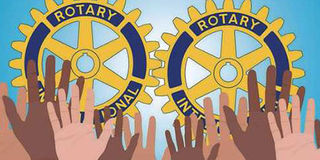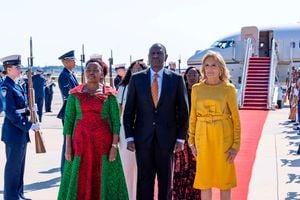A look into Rotary Club history and milestones in doing good

In the first century of its existence, membership of Rotary grew to over 1.2 million, spread over 34,000 clubs in over 200 countries. ILLUSTRATION | NATION MEDIA GROUP
What you need to know:
- Recently, realising the importance of young people for the future of Rotary, new generation was adopted as the fifth Avenue of Service.
- Women have proved that they have the Rotary DNA in their genes and they are born Rotarians, as a potential wife and mother.
Now to Rotary and I have realised that I need three columns to do justice to this wife of mine!
One to trace the history of Rotary, another one to record my role in it and the final one, to present my views after membership of over half a century and dare to make a few critical comments which might prove controversial or at least start a debate.
On February 23 this year, Rotary celebrated its 115th anniversary. A remarkable achievement for an international service club, which depends on volunteers worldwide, both for funds and service!
Its origin arose from a lawyer’s loneliness! Rotary’s founder, Paul Harris, who grew up in a tiny village of Vermont in Willingford, USA felt the need for friendship, when he started his law practice in the windy city of Chicago. ‘Not a friend in sight’ was his poignant observation.
One evening, he went to dinner with his new friend, Silvester Schiele and proposed an idea to him.
Why not gather a group of business and professional men, who would meet regularly for fellowship and exchange ideas of mutual interest and help?
Four like-minded men, the other two being Gustav Loeher and Hiram Shorey, turned up at the first meeting held on the bitterly cold evening of February 23, 1905 and the world’s first service club was born!
DO GOOD
It soon became apparent to the founders that fellowship by itself won’t endure so in addition to club service, which looked after fellowship, community, vocational and international service were added.
Recently, realising the importance of young people for the future of Rotary, new generation was adopted as the fifth Avenue of Service.
In 1916, the Rotary Foundation was established in response to a call from Arch Klumpf, a German immigrant and President of Rotary International, who in his inaugural address called on Rotarians to establish a foundation ‘to do good in the world’.
Soon it became the philanthropic arm and heartbeat of Rotary. From $28.5 savings from the the Rotary International Convention in Kansas, its deposit has grown to millions of dollars with an objective of building it to minimum of one billion.
It earns annually $100 million from donations made by Rotarians and spends it all on international projects.
The foundation uses its funds to eradicate poverty, to promote literacy and numeracy, in fact all educational and health projects, especially focusing on reduction of maternal and infant mortality, support clean water and sanitary schemes, conflict resolution and promotion of peace to help the developing world.
SMALLPOX ERADICATION
The finest hour of the Rotary Foundation is yet to come when with the help of the World Health Organisation (WHO), Unicef, Centres for Disease Control and Prevention and Bill Gates Foundation, it will eradicate polio from the face of the earth and fulfil its promise to the children of the world, it made in 1985.
Rotary took its cue from the WHO which eradicated smallpox from the world. The original idea was to give this as a gift to children to celebrate its centenary in 2005, but despite heroic efforts made by Rotarians and over a billion dollars spent, unexpected challenges made it impossible to meet the deadline.
However, with fresh impetus, the eradication of the disease is in sight. Nevertheless, from thousand cases a day, there were only 22 cases recorded in 2017 and there are two countries, Pakistan and Afghanistan, in which it is prevalent, because of the fighting, but there, too, we are on the last mile of our run.
In the first century of its existence, membership of Rotary grew to over 1.2 million, spread over 34,000 clubs in over 200 countries.
Like the British Empire, the sun never set on Rotary. The overall membership of Rotary increased every year except the war years and the economic depression of 1929.
WOMEN ADMISSION
But in the second century, the situation is very different, the consequences of which will be discussed in my critical review.
In 1987, women were admitted into Rotary, initially in USA but by 1989, after the Council on Legislation, Rotary’s parliament, which meets every three years, passed a resolution to that effect.
In view of women getting the vote, participating as equal and taking part in all professions including politics and role models like Golda Meir, Indira Gandhi and Margaret Thatcher, the move to admit women was gaining momentum.
To compound it all, people of goodwill were pointing at Mother Teresa and Pearl Buck, the Nobel Laureate in literature and urging Rotary to come out of the Victorian era, which prevailed when Rotary started.
Above all, it seemed ridiculous to deny half the population of the world entry to Rotary. Medical Rotarians like me argued that women were anatomically different, and thank God they were, otherwise we would have problems in the bedroom; nevertheless, they were not unequal.
TRUE WORTH
Though there was a move to admit women in Rotary since 1975, no specific action was taken until the Supreme Court in USA ruled that by denying admission to women, Rotary was violating the Constitution of the country.
The court action arose in 1978 when the Rotary Club of Duarte in California invited three women to join the club.
Rotary went to court and lost the case. Successively senior courts gave different verdicts until finally the Supreme Court gave judgement against Rotary as above.
Since women were allowed in Rotary and since the glass ceiling was broken, women have joined Rotary in hordes and have proved their worth.
They have proved that they have the Rotary DNA in their genes and they are born Rotarians, as a potential wife and mother.





